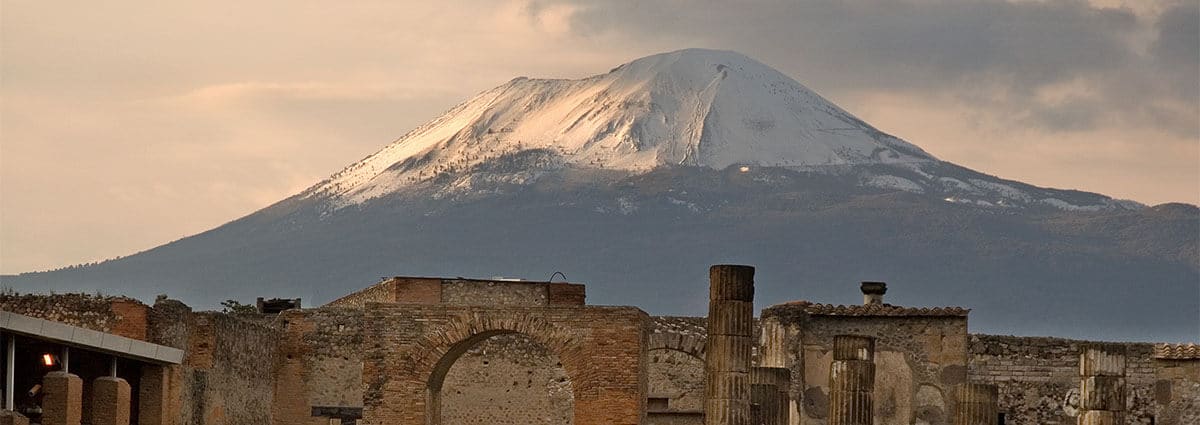Once a popular resort destination for Rome’s upper class, a tour through present day Pompeii is an eerie yet fascinating journey through the last days of life in the city and for the 2,000 citizens who perished under the wrath unleashed by Mount Vesuvius in 79 A.D. The perfectly preserved city is a time capsule showing us life in ancient times.
Pompeii is one of the most popular tourist sites in Italy and is designated a UNESCO World Heritage Site. Before its destruction, it was a bustling city of 10,000 to 16,000 people only five miles from Mount Vesuvius and near the largest port of Pozzuoli. It was an agricultural hub due to its mild climate and fertile soil. Trade flourished with its proximity to a port.

Mount Vesuvius was a known volcano and people who lived in the area had learned to live with it – tolerating its occasional eruptions and earthquakes over thousands of years. The Romans may have thought it extinct and could never have imagined its destructive power.
On the day of the cataclysmic eruption in 79 A.D. (thought to be in August), the first eruption shot ash and rocks into the air. Most Pompeiians fled. The approximately 2,000 souls who stayed behind perished. Many sought shelter from the ash and died as buildings collapsed. A pyroclastic surge proved deadly for anyone left. Hot gas, ash and rock shot down the sides of the mountain into town at 100 miles per hour. An estimated 13,000 to 16,000 people in the region died.
After the eruption, the city was buried under 13 to 19 feet of ash, abandoned and forgotten until discovered by explorers in 1748. As they dug, they found the city perfectly preserved by ash as it was on the day of the eruption. Some buildings were found intact and skeletons lay where they fell at the time of the eruption. An Italian archaeologist realized that the voids he found while excavating in layers of ash were spaces left by decomposed human bodies and started using plaster to cast these bodies frozen in time. It’s a strange feeling to see these long-gone people cast in time at their death. More than a thousand casts have been made.

Notable sites to see in Pompeii
- Forum of Pompeii
This was the center of the city with a large open space probably used as a marketplace. Although most of the buildings are in ruins, you get an idea of the once-grand city here. The arch on the west side is attributed to Emperor Augustus and to the east, Emperor Nero though it was torn down.
- Thermal Baths
There were a number of bath complexes in the city. Since few houses had water, people used the public bath houses. Thermal bath buildings were heated by running water through the walls. The baths have separate sections for men and women with a series of rooms for changing, latrines, cold bath, tepid bath and hot bath. Some even included a gym and pool. Sounds like a modern day health club.

- Theatres
A large theatre was built into a hillside with horseshoe-shaped stands organized into three sections for seating based on class level. The stands were covered by a retractable canopy to protect spectators from weather. Plays, music, comedies and other performances occurred here. Nearby, a smaller theatre has a special ceiling for better acoustic quality, possibly for music and poetry readings.
- Temples
There are many temples in Pompeii because Pompeiians worshiped many gods. The Roman temples were designed with an altar in front to hold the statue of the particular god or goddess and priests held ceremonies and sacrifices there. The Temple of Apollo is thought to be the oldest structure in Pompeii. You can see replicas of the statue of Apollo and the bust of Diana found here.

- Houses
Large and small houses existed in the city. And as you walk through you may see geometric floor patterns, frescoes, beautiful decorations and details. Walk in the footsteps and think about the daily lives of the people that once lived here. Is this the house of a wealthy merchant or an artisan?

Tips for your visit to Pompeii
- Take the Windstar tour with a knowledgeable guide – it’s worth it
- Pompeii is a burial site – be respectful
- No large bags allowed inside
- Wear flat walking shoes; cobblestone streets are uneven
- Bring a water bottle and sunhat; wear sunscreen
- Notice the art as well as the architecture
- Remember this is an active excavation site with closures and ongoing work
- Pause. Take some quiet time in the ruins to take it all in.
Pompeii is a 30 minute drive from Sorrento, featured on our Classic Italy and the Dalmatian Coast itinerary.




















































A good set of suggestions. One point: don’t worry about crowds of tourists. This is a city. It can absorb large crowds. In fact crowds give it life.
I’ve been there several times, but the most memorable was when I took my seven-year-old daughter down on the train from Rome. A few hours in Pompeii, then the train back. Wonderful.